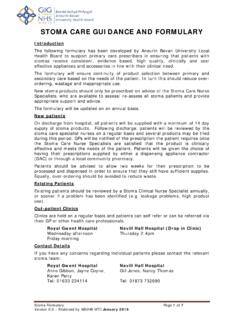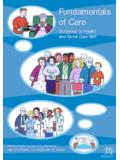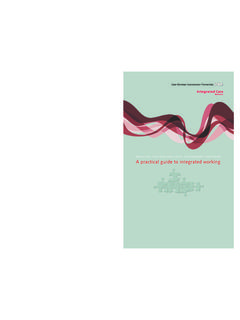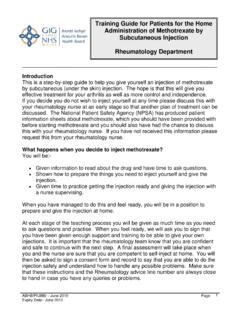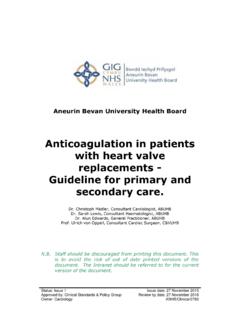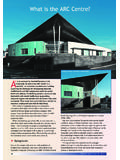Transcription of All Wales NHS Dress CodeFree Free to Lead, to Care
1 1 All Wales NHS Dress CodeFree to Lead, Free to Care2 IntroductionThe All Wales Dress code was developed to encompass the principles of inspiring confidence, preventing infection and for the safety of the public expect all healthcare workers to project a professional image. Though not all staff may be required to wear a uniform, the requirement to present a smart, professional image applies to everyone. Securing the confidence of the public is paramount in delivering exemplary health care services. Evidence has shown that the public is concerned about a number of issues relating to the wearing of NHS uniforms and the comportment of NHS evidence base for the All Wales Dress code was developed by the Department of Health in England.
2 Uniforms and Workwear: an evidence- based document on the wearing and laundering of uniforms was originally published in 2007 and updated in 2010. It is available at The wearing of an NHS uniform and/or workplace clothing must address key Health and Safety recommendations: Adhere to infection prevention and control protocols especially in relation to hand washing techniques the identification a corporate image for the individual provide a professional image to promote public confidence provide the wearer with mobility and comfort be resilient to withstand rigorous laundering take into account staff safety in relation to situations involving violence and aggression The Dress code specifies the principles that all NHS staff must adhere to and highlights specific expectations for all staff directly
3 Involved in the delivery of clinical services. The Dress code applies equally across clinical and non-clinical staff working within NHS and expectationsPRINCIPLE 1 All staff will be expected to Dress in smart (that is, neat and tidy) clean attire in their :All staff Staff must adhere to the NHS Wales Dress code principles on the wearing and laundering of uniforms/work attire Staff must wear their uniforms/work clothes in a manner that will inspire public confidence The special needs of pregnant staff must be assessed and advice obtained from their occupational health departments The special needs of disabled staff must be assessed and advice obtained from their occupational health departments Crown Copyright 2010 WAG10-10214 ISBN.
4 978 0 7504 5701 9 F3603 Staff working in the clinical environment Clean uniform/work attire must be worn for each shift/work day Clinical staff must have access to a change of uniform should their uniform be contaminated during their shift/work day Where staff launder their own uniforms, written instructions must be adhered to which reflect current best practice guidelines ( Appendix 2) Staff should use additional protective clothing when anticipating contact with blood and/or bodily fluids in line with their local infection prevention and control policiesPRINCIPLE 2 All staff will present a professional image in the :All staff Staff will wear their hair neatly.
5 Medium length/long hair must be tied up off the shoulder and secured Staff must not wear jewellery except for plain wedding ring/kara/ear studs No wrist watches are to be worn under any circumstances in the clinical environment Staff with pierced ears may wear one set of stud earrings only Staff with new piercings (where the piercing cannot be removed for a specific time period) must cover them with a Blue plaster Staff with established body piercings, other than earrings, (one set of studs) should cover them when in the workplace Staff with beards must keep the beard neatly trimmed Staff must not wear false nails and/or nail varnish Staff must keep their finger nails clean and short Staff must wear footwear that complies with the relevant health and safety requirements, for example, soft soled for reduced noise, low heeled for manual handling and ease of movement.
6 And closed toes for protectionPRINCIPLE 3 Staff should not socialise outside the workplace or undertake social activities while wearing an identifiable NHS uniform. Expectation:Staff working in the clinical environment Where changing facilities are available, staff must change out of their uniform at the end of a shift before leaving their place of work Where changing facilities are NOT available staff should ensure their uniform is covered up before leaving their place of work Staff must not wear their uniforms in public places, for example, shops (if staff need to enter public places in the course of their duties they must make every effort to cover their uniforms)
7 Staff who are permitted to wear a uniform to and from work, or work in the community setting, must cover their uniform when travelling4 PRINCIPLE 4 All clinical staff must wear short sleeves or elbow-length sleeves in the workplace to enable effective hand washing :Staff working in the clinical environment Staff will comply with the above in order to ensure that correct hand hygiene can be performed before contact with patients PRINCIPLE 5 All staff must wear clear identification at all :All staff Staff must wear identification (for example, a security coded name badge) that includes their title, name and profession at all times , in line with their local policies, for example, a Lone Worker Policy Staff identification must be clearly visiblePRINCIPLE 6 Staff who wear their own clothing for work should not wear any clothing that is likely to cause a safety hazard.
8 Expectation:All staff Staff should not wear any loose clothing that may compromise their health and safety in the work place Footwear should be comfortable and practical for the role undertakenImplementation and monitoringThe All Wales NHS Dress code will replace any local policy in order to ensure equity and parity across all healthcare organisations. Compliance will be monitored through local agreement at a local line with the Welsh Assembly Government Inclusive Policy Guidelines this document will be reviewed in December of Health (2010) Uniforms and Workwear: an evidence-based document on the wearing and laundering of uniforms Department of Health (2006) Safety First: a report for patients and healthcare managers DoH: LondonHealth and Safety Commission (2000) Securing Health Together HSE: LondonHMSO (1974) Health and Safety at Work Act 1974 HMSO.
9 LondonHMSO (1992) Manual Handling Operations Regulations HMSO: LondonHMSO (1999) Management of Health and Safety at Work Regulations HMSO: LondonHMSO (2002) Control of Substances Hazardous to Health RegulationsHMSO: LondonHMSO (2002) Personal Protective Equipment Regulations HMSO: LondonHMSO (2006) Health Act 2006 code of Practice HMSO: LondonJacob, G (2007) Uniforms and Workwear. An evidence base for developing local policy Department of Health, LondonNHS Borders (2004) Dress code /Uniforms PolicyRoyal College of Nursing (2009) Guidance on uniforms and work wearRoyal College of Nursing (2005) Wipe It Out.
10 RCN Campaign on MRSA. Guidance on uniforms and clothing worn in the delivery of patient care Royal College of Nursing: London6 Appendix 1 Supporting informationGood PracticeRationaleSupporting Information and /or additional commentsWear short sleeves or roll the sleeves to elbow length before carrying out clinical procedures Cuffs become heavily contaminated and are more likely to come into contact with patientsThey may act as a vehicle for transmitting infection Long sleeves or cuffs prevent effective hand washing and compromise patient safetySome staff working in an outdoor environment, for example, ambulance personnel.
